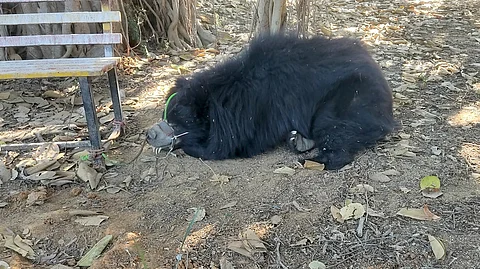

The State Forest Department of Bihar has seized four live sloth bears (three males and one female) from a village close to the interstate border of Jharkhand and Bihar.
This is the third incident of seizures out of a total of eight sloth bears in the past three months from different districts of Bihar and Jharkhand. An alarm of resurgence has been raised in illegal wild animal trade in the region which was stopped over a decade ago.
In mid-March, the Department of Environment, Forest & Climate Change had seized four sloth bears, kept the matter underwraps as investigation was underway. The enforcement agency has arrested seven suspects so far. All four bears have been shifted to Bihar’s Rajgir Zoo.
Meanwhile, in January, three sloth bears were seized in Bhagalpur district, Bihar followed by the seizure of a sloth bear cub in Godda district, Jharkhand in February.
Over the past two years alone, five cases have surfaced, indicating that this cruel practice which was once thought to be eradicated in India is far from over.
The seized sloth bears' muzzles were pierced and their teeth and claws were broken, indicating that they were trained under harsh conditions for dance performances by the ‘Kalandar’ community in India and ‘Natiya’ community in Nepal.
The seized bears were being exploited for the illegal dancing bear trade, in violation of the Wildlife (Protection) Act (WPA), 1972.
Endemic to the Indian subcontinent, Sloth Bear is listed as ‘Vulnerable’ by the IUCN Red List and protected under Schedule I of The WPA.
The species is easily identifiable by its shaggy black coat, elongated muzzle, protruding lip, and a distinctive white V-shaped patch on its chest.
“This enforcement operation was a culmination of months of surveillance and investigations by the State Forest Department, assisted by the Wildlife Trust of India,” says Jose Louies, Chief of Enforcement, Wildlife Trust of India (WTI), a New Delhi based non-profit advocating for the conservation of environment and wildlife.
Last year, also, WTI alerted the Jharkhand Forest Department in conducting successful enforcement operations between September and November 2022, resulting in the rescue of four live sloth bears from the Deoghar and Bokaro Districts.
The different state governments in collaboration with non-profits had eradicated ‘dancing’ bear tradition in India by rescuing the sloth bears and rehabilitating the Kalandars through interdisciplinary efforts. Another community based in Nepal ‘Natiya’ engaged in dancing bear profession is also a concern for state enforcement department.
“This sudden resurfacing of cases involving the poaching of sloth bear cubs from the wild and their training for performances is deeply concerning. Stopping these instigators is the major challenge to sloth bear conservation today” said Jose.
Our team has found that traders from villages in eastern Uttar Pradesh and Bihar are scouting these potential trade areas and placing their ‘demand’ for bear cubs in the local communities. Stopping these instigators is the major challenge to sloth bear conservation today,” said Louies.